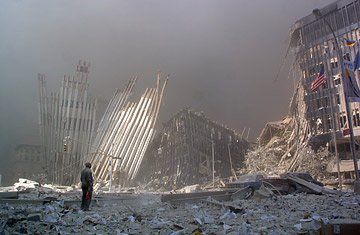
A man stands in the rubble, and calls out asking if anyone needs help, after the collapse of the first World Trade Center Tower in New York City on September 11, 2001.
(9 of 10)
The president and CEO of the American Society for the Prevention of Cruelty to Animals, Hawk quickly mobilized a team of veterinarians, police officers and pet psychologists to escort pet owners through the dead zone to their former apartments. Wearing a green A.S.P.C.A. T shirt over his plaid shirt and chinos, Hawk listened to their stories and calmly vowed to help. He was on hand to reunite Leslie Long and Doug Murray with their two cats, which had survived for 48 hours on little more than toilet water. Their apartment was coated with several inches of filth, with only a trail of paw prints peeking through the dust.
Hawk also worried about the welfare of the police dogs sifting through the rubble. Many of their paws were torn on jagged wreckage, and rescuers had begun wrapping their legs in flimsy burlap. Hawk and his colleagues started a collection drive for protective doggie booties. In a week like this, some might find it strangely incidental to pay so much attention to pets. Hawk disagreed. "I spend my life teaching humane principles. If we learn how to be more humane to animals, we hope it will rub off on people," Hawk said. He paused. "What happened to my sister was very inhumane." --By Jodie Morse
The Stations of Grief
It might be easier to believe the Twin Towers had been knocked to the ground if people at the 69th Regiment Armory were crying, if they were clinging to one another in tight bunches, filling the gaping auditorium with sobs. But they aren't. Assembled in the hall are thousands of the walking wounded--the hollow-eyed mothers, lovers, brothers of people who went to work two days ago and disappeared. They answer police officers' questions, they hand over dental records, they describe the meaning of obscure tattoos, they feel sick, they tear up, they pick at ham sandwiches. But only very rarely does someone begin to weep.
Which is not to say that these people--plastering the city with MISSING flyers, giving strangers intimate descriptions of a boyfriend's piercings--hold out much hope that their loved ones are alive. They know better, of course. But they need time, time to find some way to fit what has happened into the story of their lives.
In the long line for filing missing-persons reports, an elderly couple holds hands and stares straight ahead, not speaking. A pregnant woman in a brown knit dress shifts her weight from one foot to the other. And Felipe Oyola, 24, and his mother-in-law Nelida Rivera fill in a form that more than 4,900 other families have filed since Sept. 11. Name: Adianes Cortez-Oyola. Birthday: Aug. 9, 1978. Marital status: Married--on March 25, 2000 (in St. Agatha's Church in Brooklyn; she and Felipe planned it all themselves).
Felipe and Adianes met seven years ago, when they worked together after school at Roy Rogers. They were still working together, at Fuji Bank's offices in the World Trade Center's south tower. They rode the bus together each morning. She would go to the 82nd floor, where she supervised the payroll; he went one floor below, to run the mailroom. One floor can make all the difference.
